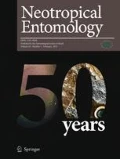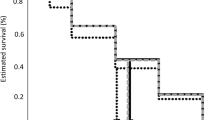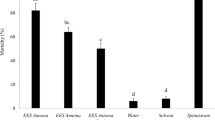Abstract
The development of appropriate methodologies for bioassays is of paramount importance to study the methodological factors that may interfere in the experimental design. Thus, laboratory bioassays have become increasingly important for the determination of data that are realistic and replicable. The objective of the study was to develop a bioassay methodology with the ready-to-use toxic bait Success™ 0.02CB, 96 mg L−1 of spinosad, in adults of Ceratitis capitata (Wiedemann) as a study model. The insect origin (laboratory population, LT50 = 11.16 h), time of toxic bait supply (4 h, LT50 = 16.85 h), food deprivation (12 h, LT50 = 15.55 h), and the adult age (5 days, LT50 = 35.31 h) of C. capitata showed higher susceptibility and a shorter LT50 lethal time to the Success™ 0.02CB toxic bait. However, the absence or presence of a food source (LT50 ≈ 31.17 h) during the bioassay did not affect the susceptibility of C. capitata. Further, adults of C. capitata who were deprived and in the absence of a food source (artificial diet) had higher consumption of toxic baits (mg) during treatment exposure. The use of a 12-h deprivation period, toxic baits offered for 4 h, and absence of an artificial diet for adults of C. capitata at 5 days of age during the bioassay are considered adequate for evaluating formulations of toxic baits under laboratory conditions.





Similar content being viewed by others
References
Adaime R, Santos RS, Azevedo TS, Vasconcelos AS, Souza MSM, Souza-Filho MF (2017) First record of Ceratitis capitata (Wiedemann) (Diptera: Tephritidae) in the State of Acre, Brazil. EntomoBrasilis 10:259–260
Agrofit (2018) Sistema de agrotóxicos fitossanitários. Available at: http://extranet.agricultura. gov.br/agrofit_cons/principal_agrofit_cons. Accessed July 2016
Araújo EL, Juliatti FC, Ferreira ADCL, Fernandes EC, Sousa MM (2013) Eficiência de acetamiprido e etofenproxi no controle de Ceratitis capitata (Diptera: Tephritidae), na cultura da mangueira. ASCA: Agropec Cient Semi-árido 9:99–103
Arita LH (1982) Reproductive and sexual maturity of the Mediterranean fruit fly, Ceratitis capitata (Wiedemann). Proc Hawaii Entomol Soc 24:25–29
Baronio CA, Bernardi D, Paranhos BAJ, Garcia FRM, Botton M (2018) Population suppression of Mediterranean fruit fly Ceratitis capitata (Wiedemann) on table grapes using toxic baits. An Acad Bras Ciênc. No prelo
Barry JD, Miller NW, Piñero JC, Tuttle A, Mau RFL, Vargas RI (2006) Effectiveness of protein baits in melon fly and oriental fruit fly (Diptera: Tephritidae): attraction and feeding. J Econ Entomol 99:1161–1167
Bateman MA, Morton TC (1981) The importance of ammonia in proteinaceous attractants for fruit flies (Diptera: Tephritidae). Aust J Agric Res 32:883–903
Borges R, Machota-Jr R, Boff MIC, Botton M (2015) Efeito de Iscas Tóxicas sobre Anastrepha fraterculus (Wiedemann) (Diptera: Tephritidae). Bioassay 10:1–8
Botton M, Arioli CJ, Machota-Jr R, Nunes MZ, Rosa JM (2016) Moscas-das-frutas na fruticultura de clima temperado: situação atual e perspectivas de controle através do emprego de novas formulações de iscas tóxicas e da captura massal. Rev Agropec Catarinense 29:103–107
Couso-Ferrer F, Arouri R, Beroiz B, Perera N, Cervera A, Navarro-Llopis V, Castañera P, Hernández-Crespo P, Ortego F (2011) Cross-resistance to insecticides in a malathion-resistant strait of Ceratitis capitata (Diptera: Tephritidae). J Econ Entomol 104:1349–1356
Fitt GP (1986) The roles of adult and larval specializations in limiting the occurrence of five species of Dacus (Diptera: Tephritidae) in cultivated fruits. Oecologia 69:101–109
Gazit Y, Gavriel S, Akiva R, Rimar D (2013) Toxicity of baited spinosad formulations to Ceratitis capitata: from the laboratory to the application. Entomol Exp Appl 147:120–125
Härter WR, Botton M, Nava DE, Grutzmacher AD, Gonçalves RS, Machota-Jr R, Bernardi D, Zanardi OZ (2015) Toxicities and residual effects of toxic baits containing spinosad or malathion to control the adult Anastrepha fraterculus (Diptera: Tephritidae). Fla Entomol 98:202–208
Henderson CF, Tilton EW (1955) Tests with acaricides against the brow wheat mite. J Econ Entomol 48:157–161
Humeres E, Da-Cruz IBM, Oliveira AK (1999) Age and time exposure-related toxicity of Fenthion to male and female Anastrepha fraterculus (Wied.) (Diptera: Tephritidae). An Soc Entomol Brasil 28:285–291
Kapsi R, Mossinson S, Drezner T, Kamensky B, Yuval B (2002) Effects of larval diet on development rates and reproductive maturation of male and female Mediterranean fruit flies. Physiol Entomol 27:29–38
Kouloussis NA, Damos PT, Ioannou CS, Tsitsoulas C, Papadopoulos NT, Nestel D, Koveos S (2017) Age related assessment of sugar and protein intake of Ceratitis capitata in ad libitum conditions and modeling its relation to reproduction. Front Physiol 8:1–13
Manrakhan A, Lux AS (2008) Effect of food deprivation on attractiveness of food sources, containing natural and artificial sugar and protein, to three African fruit flies: Ceratitis cosyra, Ceratitis fasciventris, and Ceratitis capitata. Entomol Exp Appl 27:133–143
McQuate GT, Liquido NJ (2017) Host plants of invasive tephritid fruit fly species of economic importance. Int J Plant Biol Res 5:1072
Medina P, Perez I, Budia F, Adan A, Vinuela E (2007) Development of an extended-laboratory method to test novel insecticides in bait formulation. IOBC/WPRS Bull 26:59–66
Morelli R, Paranhos BAJ, Costa MLZ (2012) Eficiência de etofenproxi e acetamiprido no controle de mosca-do-mediterrâneo Ceratitis capitata (Diptera: Tephritidae) em pomar de manga. Bioassay 7:1–4
Navarro-Llopis V, Primo J, Vacas S (2012) Efficacy of attract-and-kill devices for the control of Ceratitis capitata. Pest Manag Sci 69:478–482
Nestel D, Nemny-Lavy E, Zilberg L, Weiss M, Akiva R, Gazit Y (2004) The fruit fly PUB: a phagostimulation unit bioassay system to quantitatively measure ingestion of baits by individual flies. J Appl Entomo 128:576–582
Nunes A, Cosca KZ, Faggioni KM, Costa MLZ, Gonçalves RS, Walder JMM, Garcia MS, Nava DE (2013) Dietas artificiais para a criação de larvas e adultos da mosca-das-frutas sul-americana. Pesq Agropec Bras 48:1309–1314
Paramasivam M, Selvi C (2017) Laboratory bioassay methods to assess the insecticide toxicity against insect pests-a review. Journal of Entomology and Zoology Studies 5:1441–1445
Prokopy RJ, Miller NW, Piñero JC, Oride L, Chaney N, Revis H, Vargas RI (2004) How effective is GF-120 fruit fly bait spray applied to border area sorghum plants for control of melon flies (Diptera: Tephritidae)? Fla Entomol 87:354–360
Raga A, Sato ME (2005) Effect of spinosad bait against Ceratitis capitata (Wied.) and Anastrepha fraterculus (Wied.) (Diptera: Tephritidae) in laboratory. Neotrop Entomol 34:815–822
Raga A, Sato ME (2011) Toxicity of neonicotinoids to Ceratitis capitata and Anastrepha fraterculus (Diptera: Tephritidae). J Plant Prot Res 51:413–419
Raga A, Sato ME (2016) Controle Químico de moscas-das-frutas. Agência Paulista de Tecnologia dos Agronegócios, São Paulo, pp 1–14
Raga A, Galdino LT (2018) Mosca das frutas: Atração Fatal. Cultivar 109:20–23
Robertson JL, Russell RM, Preisler HK, Savin NE (2007) Bioassays with arthropods. CRC, Boca Raton, FL
Rull J, Prokopy RJ (2000) Attraction of apple maggot flies, Rhagoletis pomonella (Diptera: Tephritidae) of different physiological states to odour-baited traps in the presence and absence of food. Bull Entomol Res 90:77–88
SAS Institute (2011) SAS System - SAS/STAT. computer program, version 9.2. By SAS Institute, Cary, NC. 84p
Silva-Neto AM, Dias VS, Joachim-Bravo IS (2010) Importância da ingestão de proteína na fase adulta para o sucesso de acasalamento dos machos de Ceratitis capitata Wiedemann (Diptera: Tephritidae). Neotrop Entomol 39:235–240
Stark JD, Vargas RI, Miller N (2004) Toxicity of spinosad in protein bait to three economically important tephritid fruit fly species (Diptera: Tephritidae) and their parasitoids (Hymenoptera: Braconidae). J Econ Entomol 97:911–915
Vargas RI, Millar NW, Prokopy RJ (2002) Attraction and feeding responses of Mediterranean fruit fly and a natural enemy to protein baits laced with two novel toxins, phloxine B and spinosad. Entomol Exp Appl 102:273–282
Warburg MS, Yuval B (1997) Circadian patterns of feeding and reproductive activities of Mediterranean fruit flies (Diptera: Tephritidae) on various hosts in Israel. Ann Entomol Soc Am 90:487–495
Yee LW, Alston DG (2016) Sucrose mixed with Spinosad enhances kill and reduces oviposition of Rhagoletis indifferens (Diptera: Tephritidae) under low food availability. J Entomol Sci 51:101–112
Zwolfer H (1983). Life system and strategies or resource exploitation in tephritids. In: The International Symposium on fruit flies of Economic Importance, 1982, Athens. Proceedings. Rotterdam: CEC, 1983. p. 16
Acknowledgments
The first author gratefully acknowledges the National Council for Scientific and Technological Development (CNPQ) for a doctoral scholarship supporting research funding.
Author information
Authors and Affiliations
Contributions
CAB planned, designed, and executed the experimental work and wrote the manuscript; DB conducted the data analyses and wrote the manuscript, MZN and JP planned and executed the experimental work, and FRMG and MB wrote the manuscript.
Corresponding author
Additional information
Edited by Rafael M Pitta – Embrapa
Publisher’s Note
Springer Nature remains neutral with regard to jurisdictional claims in published maps and institutional affiliations.
Rights and permissions
About this article
Cite this article
Baronio, C.A., Bernardi, D., Nunes, M.Z. et al. Bioassay Method for Toxicity Studies of Toxic Bait Formulations to Ceratitis capitata (Diptera: Tephritidae). Neotrop Entomol 48, 356–363 (2019). https://doi.org/10.1007/s13744-018-0653-0
Received:
Accepted:
Published:
Issue Date:
DOI: https://doi.org/10.1007/s13744-018-0653-0




